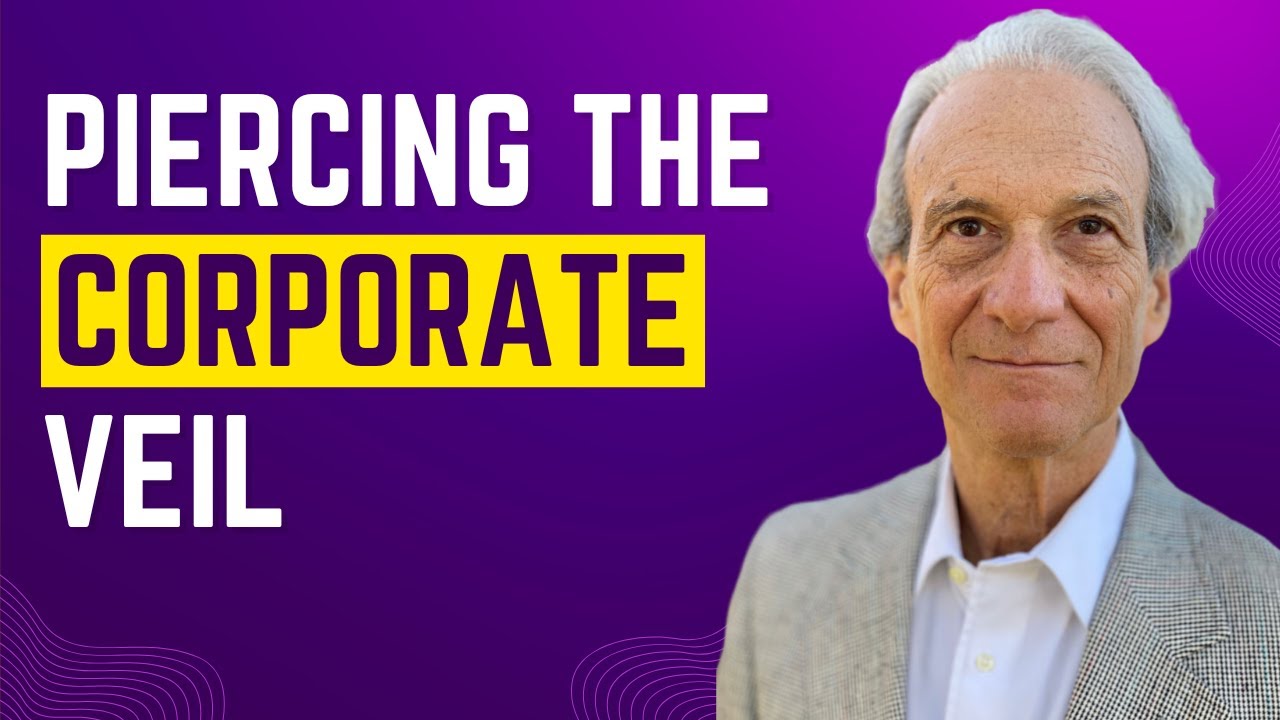Piercing the Corporate Veil in Florida
Piercing the corporate veil refers to the creditor tactic where a creditor with a judgment against a business pierces the corporation and transfers the judgment to the individual owners. Many business owners are worried that their creditors will pierce the corporate veil, putting their family’s assets at risk.
One of the most important functions of a company, whether it is a corporation or LLC, is its liability shield. The liability shield prevents the liability of the company from extending to its owners.
In other words, if a small business company is found liable for a debt, then that liability will not also be shared by the owner in his individual capacity. This limited liability encourages individuals to invest their money to start a company—otherwise, potential business owners would subject themselves to unlimited personal financial risk when forming an LLC or corporation.
A creditor who successfully pierces the corporate veil in Florida makes the individual liable for the company’s debt despite the traditional liability shield.
Requirements to Pierce the Corporate Veil
Under Florida law, it is very difficult to pierce the corporate veil with a corporation or LLC so long as the corporation or LLC is operated as a distinct and separate entity for a legitimate business purpose.
In Dania Jai-Alai Palace, Inc. v. Sykes, the Florida Supreme Court established the standard to be applied in a piercing the corporate veil claim. Under Florida law, piercing the corporate veil requires:
- The business entity must be a mere instrumentality or alter ego of the defendant.
- The business must have engaged in “improper conduct” or a “fraudulent purpose.”
- The individual owner’s improper or fraudulent use of the business entity caused damages to the business’s creditor.
The corporate veil should not be pierced unless it is shown that the corporation was organized or employed to mislead creditors or to work a fraud on them.
We help protect what you’ve earned.
Jon Alper and Gideon Alper are nationally recognized experts in asset protection planning and implementation. In over 30 years, we have advised thousands of clients about how to protect their assets from judgment creditors.
We provide all services remotely by phone or Zoom.

First Element: Alter Ego
The first element for piercing the corporate veil requires a creditor to prove that the business is an alter-ego of the debtor. One court explained that the creditor must show that the “shareholder dominated and controlled the corporation to such an extent that the corporation’s independent existence, was in fact non-existent and the shareholders were in fact alter egos of the corporation.”
The most prevalent reason for a corporation (or an LLC) to be treated as the owner’s “alter-ego” is where the owner pays his personal expenses out of the corporation and withdraws money from the corporation as needed.
The proper practice is for your corporation to pay the owner and other employees a periodic salary and dividends (or in the case of an LLC, member distributions).
Courts usually look at a list of factors that could show that the company is an alter-ego of the individual. These piercing the corporate veil factors include, for example:
- Failure to follow corporate formalities. But note: just because the business owner does not update corporate records and minutes each year in a timely manner is not sufficient to pierce the corporation.
- Inadequate capitalization. In other words, not funding the company with enough money or assets.
- Comingling of assets. For example, putting all of your personal money in the company’s account, or vice-versa.
We suggest maintaining a separate corporate bank account and that you do not commingle personal money unless clearly documented as loans. In short, respect the separate existence of your business and do not treat the business checking account as your personal savings account or piggy bank. If you follow these simple guidelines, a creditor is unlikely to defeat corporate asset protection under Florida law.
Second Element: Improper Purpose
The second element for piercing the corporate veil is whether the business entity was formed for an improper or fraudulent purpose. In other words, even if the company is a complete alter-ego of the shareholder, a creditor will still be unable to pierce the corporate veil unless the company also was formed for an improper purpose.
Improper purpose includes, for example, a company formed to commit fraud, a company formed to evade the law or evade responsibility for a debt, or a company formed to mislead creditors.
For example, in one case, a franchisee formed a corporation with no assets and with no business purpose other than being the signor on a real estate lease; when the business failed the landlord had only an empty corporate shell to sue for damages. The court permitted veil piercing in that case.
Note that the improper purpose and fraud test refers to the reason the business entity was formed as opposed to something the business did after formation.
Third Element: Causation
The third element of piercing the corporate veil in Florida is whether the improper formation of the corporation or LLC caused the creditor damages. Piercing is not warranted if damages were caused, for instance, by the entity’s failure to pay a debt as opposed to the owner’s improper purpose for his business entity.
The creditor must demonstrate a nexus between the individual’s formation and use of the business entity and the plaintiff’s injury.
Piercing a Single Member LLC
Single member LLCs do not provide acceptable asset protection because Florida law permits the creditor to levy and foreclose the debtor’s 100 percent ownership interest. On the other hand, a creditor cannot levy and foreclose a debtor’s membership interest in a multi-member LLC.
The distinction between single and multi-member LLCs is applicable when a creditor has a judgment against the individual debtor for a cause of action unrelated to the LLCs business and conduct.
When the creditor asserts a claim against the LLC itself for an LLC debt or an LLC action, there is no distinction between the defenses provided through a single member and multi-member LLC. In either case, the creditors’ claim is against the LLC itself, and the creditor of the LLC cannot collect from the LLC owner’s assets unless the creditor pierces the LLC protective veil.
The same rules apply to piercing the corporate veil for a single member LLC as to a multi-member LLC.
An opinion issued by Florida’s third district court of appeal showed the hurdles a creditor must overcome to pierce the veil of a single member Florida LLC. The court said a creditor must prove that:
- The debtor LLC had no business and existence independent from its single member owner;
- The individual owner used his LLC for a fraudulent and improper purpose; and
- The owners fraudulent or improper uses of the LLC corporate form was the cause of damages to the creditor.
After studying the facts, the court found that this debtor LLC had an independent existing interest, as it owned property, conducted significant business, and maintained its own LLC bank account. The court rejected the creditor’s argument that the LLC was established for an improper purpose to protect the owner from personal liability because the creditor was not prohibited from requiring the owner sign a separate personal guarantee. And, the court said that the creditor’s damages were caused by the LLC’s inability to pay a contracted LLC debt and not because of any of the owner’s improper use of an LLC to conduct business.
Subsequent court decisions have shown the difficulty in piercing a corporation or an LLC. For example, in Segal v. Forastero, a District Court said that a creditor cannot pierce a corporation to create a judicially imposed personal guaranty of a note or contract. Among other things, that court said that a contractual obligation signed by an LLC that currently had no assets, business, or bank account did not give rise to a piercing action when the LLC previously was actively engaged in commercial business.
Reverse Piercing
Reverse piercing is a lesser-known, and lesser-used, concept where a creditor of an individual can execute on corporate assets to satisfy a civil judgment against the individual owners. A creditor can use the reverse-pierce remedy to hold a corporation liable for the debts of the controlling owner where the owner/debtor formed or used the corporation to secret assets and avoid preexisting personal liability.
For example, if an individual facing a possible individual judgment creates a corporation or LLC and transfers his personal assets into his controlled entity to evade collection, then the individual’s judgment creditors could levy upon the corporation/LLC assets under the reverse-piercing theory.
The reverse-piercing remedy is like a fraudulent conveyance; both legal concepts are equitable remedies to execute a civil judgment. A creditor can sue a corporation that received the owner’s personal assets to help the owner escape personal liability under either theory. A leading case on reverse-piercing of a corporation is Braswell v. Ryan Investments, 389 So. 2d 38.
Frequently Asked Questions
What is piercing the corporate veil in Florida?
Piercing the corporate veil is a legal concept where courts set aside limited liability protection and hold the company’s shareholders or directors personally liable for the company’s debts and obligations.
What are corporate formalities, and why are they important?
Corporate formalities include maintaining separate financial records, holding regular board meetings, and properly documenting company actions. Adhering to these formalities helps preserve the corporation’s separate legal identity.
What are the consequences of piercing the corporate veil?
The primary consequence is that shareholders or directors can be held personally liable for the corporation’s debts and obligations, potentially risking their personal assets.
Sign up for the latest information.
Get regular updates from our blog, where we discuss asset protection techniques and answer common questions.









